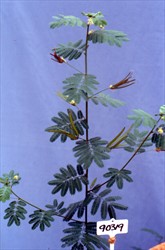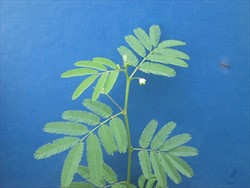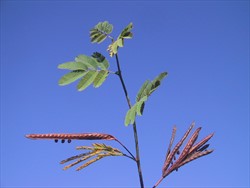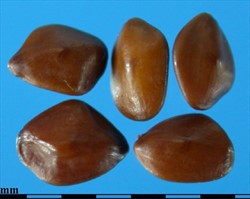Desmanthus glandulosus
Tropical Forages
Desmanthus glandulosus (B.L. Turner) Luckow
Note: Desmanthus virgatus was [1] [2] [3] regarded by Turner (1950), as an all-encompassing species, comprising D. virgatus [1] [2] [3], D. pubescens , D. pernambucanus , D. glandulosus and D. leptophyllus. Despite taxonomic revision by Luckow (1993) that resolved the complex to distinct species, many authors continued to refer to all species as D. virgatus [1] [2] [3] in the literature until the late 1990s. Correct nomenclature is now generally used.
Family: Fabaceae (alt. Leguminosae) subfamily: Caesalpinioideae (mimosoid clade*) tribe: Mimoseae.
* Azani, N. et al. [97 authors from 54 institutions] 2017. A new subfamily classification of the Leguminosae based on a taxonomically comprehensive phylogeny. Taxon 66: 44–77.
Erect or occasionally decumbent perennial herb to 0.7 m tall, woody at the base, sparingly branched, taproot 0.5‒1 cm diameter. Young stems red or green, strongly angled with red or stramineous corky ridges, sparsely pubescent with short white hairs along the ribs; older stems terete, red or brown, glabrate. Stipules persistent or sometimes early deciduous, 1.2‒6 mm long, setiform, with a small membranous margin at the base, glabrous or sparsely pubescent, red when dry. Leaves paribipinnate, 4‒8 cm long; petiole 4‒10 mm long, rachis 10‒40 mm long, pubescent with straight white hairs; pinnae 3‒6 pairs, 20‒40 mm long; a sessile, ellipsoid, crateriform or flattened nectary inserted between the lowest pair of pinnae, a smaller orbicular nectary usually between the uppermost pair of pinnae, sometimes between all pairs of pinnae. Pinnules 14–26 pairs, 4.2–7.4 mm long × 0.8–1.4 mm wide, narrowly elliptic, ciliate along the margins with few white hairs, nearly sessile. Capitulum (flower head) 0.7–1.1 cm long, occurring singly in leaf axils on peduncles 1.8–3.0 cm long; each head containing both sterile and perfect flowers, male flowers absent. Sterile flowers, 3–7, may abscise without opening; occur at the base of the head. Perfect flowers, 5–12, 3.0–4.0 mm long, occur apically. Fruiting peduncles, 1.8–3.5 cm long, bearing 1–9 pods. Pods linear, straight or arched outwards, 5.8–10.5 cm long and 3.4–4.6 mm wide, tips acute or apiculate with ashort beak 1‒5 mm long, dehiscent along both sutures, twisting after dehiscence; valves coriaceous, glabrous red when immature, turning warm-brown at maturity, wrinkled with raised reticulate veins. Seeds 12–27 per pod, 3.0‒3.7 × 1.9–2.8 mm, oblong to rhomboid to ovate, 4-angled; golden-brown in colour.
Similar species
Desmanthus glandulosus: erect or occasionally decumbent perennial herb to 0.7 m tall; petiole of mature leaves 4‒10 mm long; pinnae 3‒6 pairs (multiple nectaries common); pinnules 14–26 pairs.
Desmanthus leptophyllus: erect (rarely prostrate or decumbent) shrub 0.4–3 m tall; petioles of mature leaves 3–14 mm long; pinnae 4–8 pairs (nectary between lowermost pair); pinnules 16–36 pairs.
Desmanthus pernambucanus: erect to decumbent perennial herbs/subshrubs, mostly 0.5–2 m tall; petioles of mature leaves 6–16 mm long; pinnae 2–4 pairs (nectary between lowermost pair); pinnules 9–21 pairs.
Desmanthus virgatus: prostrate, decumbent or erect subshrubs, typically to 1.5 m tall; petioles of mature leaves 1–5 mm long; pinnae 2–5 pairs (nectary between lowermost pair); pinnules 11–23 pairs.
English: glandular bundle-flower (USA)
Native:
Northern America: Mexico (Coahuila); USA (New Mexico, Texas)
Infrequent in the mountains of West Texas, southern New Mexico in the USA, and northern Coahuila, Mexico, on rocky limestone or rarely igneous soils in woodlands; also in drier desert scrub; at altitudes from 100 to 2,200 m asl.
Soil requirements
In cultivation, Desmanthus spp. are generally selected for their persistence on duplex podzolics and cracking clays, including alkaline and sodic soils, but will grow productively on lighter soils of neutral to alkaline reaction.
Moisture
Occurs naturally in sub-humid to semi-arid environments receiving an average annual rainfall of 250–500 mm. Small amounts of rain can fall in most months, but there are generally 8–9 months with less than 50 mm rainfall.
Temperature
Mean annual temperatures in the native range vary from 16 to 22 °C, with average temperatures for coolest and hottest months ranging from 7.4 to 10.5 °C and 24.5 to 30.6 °C, respectively.
Light
May possess some shade tolerance because of its natural occurrence under low woodlands.
Reproductive development
Flowers after summer rains from June to September and sets fruit into October in southern USA, slightly earlier in northern Mexico.
Defoliation
Tolerant of regular defoliation in cutting and grazing trials.
Fire
No information available.
Guidelines for establishment and management of sown forages.
Establishment
No information is available specifically for D. glandulosus, but information for D. virgatus [1] [2] [3] is relevant. Sow 1–2 kg/ha of scarified seed at a depth of 0.5–2.0 cm into moist soil with at least 50–60 cm depth of good moist soil to ensure establishment. Deeper planting depths may prevent or delay emergence. Surface broadcasting onto a well-prepared seedbed, followed by rolling, or planting using a “crocodile” seeder have also given good results. Has been established successfully into cultivated strips, or sod-seeded into slashed back pasture treated with glyphosate to suppress grass growth.
Fresh seed is extremely hard-seeded and should be scarified, either abrasively (e.g. using a rice polisher) or by hot water treatment (4–10 seconds in boiling water), to raise the germination to a minimum of 50–70%. It is important to achieve good establishment from the plant crop as seed produced from paddock plants will remain hard-seeded for 5–6 years.
Fertilizer
Unknown. See D. virgatus [1] [2] [3] as a guide.
Compatibility (with other species)
Similar to D. virgatus [1] [2] [3] cv. Marc, it is expected to form productive mixtures in sown pastures with tussock and sward-forming grasses adapted to sub-humid regions. Expected to be similar to cv. Marc in its compatibility, persisting in moderately to heavily grazed buffel grass (Cenchrus ciliaris) pastures, and recruiting from seed when seasons permit.
Companion species
Grasses: Cenchrus ciliaris, Dichanthium sericeum, Panicum coloratum var. makarikariense.
Pests and diseases
Occasional, minor damage by psyllid insects (Accizia spp.) was reported in northern Australia. The psyllids can cause more serious damage in seed crops. Several seed-eating bruchid beetles (several Acanthoscelides spp. and one Stator sp.) are known to infest Desmanthus. Recorded as a host for alfalfa mosaic virus. No other reports of serious pests and diseases were cited.
Ability to spread
No information available.
Weed potential
May have potential to become a weed of disturbed areas. Its low growth habit limits its ability to dominate companion species.
Nutritive value
Very limited evaluation has been conducted with D. glandulosus. See values for other Desmanthus spp. as a guide.
Palatability/acceptability
Moderately palatable to grazing ruminants. Lower than for leucaena (Leucaena leucocephala but higher than for Stylosanthes scabra cv. Seca. Accession CPI 90319A was of similar palatability to grazing cattle to most other Desmanthus accessions evaluated in Queensland, Australia, but less palatable than the most palatable accessions, D. virgatus [1] [2] [3] Q9153 and D. leptophyllus CPI 38351.
Toxicity
No toxicities to ruminant livestock were reported in the literature. Desmanthus spp. do not cause bloat in ruminants because they contain 2–3% (of total DM as tannic acid equivalent) condensed tannins.
Dry matter
Little evaluation has been undertaken, but CPI 90319A was high yielding in trials in Queensland, Australia, producing yields of 2–7 t/ha in pure plots in 600–800 mm rainfall environments.
Animal production
No reports of animal production data were cited.
Very limited evaluation, and no artificial breeding of D. glandulosus have been conducted to date. Possesses a unique combination of morphological characters so that it cannot be accurately placed in either the D. cooleyi or the D. virgatus [1] [2] [3] complexes. Morphological variation occurs within the species.
No information available.
- High DM yield in sub-humid environments.
- Very drought tolerant.
- Very hard-seeded.
- Little agronomic, and no animal production evaluations have been conducted.
Burt, R.L. (1993) Desmanthus: a tropical and subtropical forage legume. Part 1. General Review. Herbage Abstracts 63:401–413.
Burt, R.L. (2016) Searching for pasture legumes for heavy clay soils in Australian dry tropics and subtropics: IV. Evaluation in Western Queensland. In: Lazier, J.R. and Ahmad, N. (eds) Tropical forage legumes: Harnessing the potential of Desmanthus and other genera for heavy clay soils. CAB International, Wallingford, Oxon, UK. p. 204–253. doi.org/10.1079/9781780646282.0204
Hopkinson, J.M. and English, B.H. (2004) Germination and hardseededness in Desmanthus. Tropical Grasslands 38:1–16. bit.ly/2wyIPA7
Luckow, M. (1993) Monograph of Desmanthus (Leguminosae-Mimosoideae). Systematic Botany Monographs Vol. 38. American Society of Plant Taxonomists, Laramie, WY, USA. doi.org/10.2307/25027822
Pengelly, B.C. and Liu, C.J. (2001) Genetic relationships and variation in the tropical mimosoid legume Desmanthus assessed by random amplified polymorphic DNA. Genetic Resources and Crop Evolution 48:93–101. doi.org/10.1023/A:1011234913710
None released to date.
CPI 90319A Selected in Queensland, Australia. Among the highest yielding Desmanthus accessions in pure species plots in sub-humid northern Australia.








